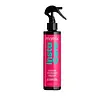What's inside
What's inside
 Benefits
Benefits

 Concerns
Concerns

 Ingredients Side-by-side
Ingredients Side-by-side

Water
Skin ConditioningPropylene Glycol
HumectantCetearyl Alcohol
EmollientCyclopentasiloxane
EmollientBehentrimonium Chloride
PreservativeQuaternium-80
Parfum
MaskingPanthenol
Skin ConditioningHydrolyzed Silk
HumectantMorus Alba Leaf Extract
Skin ConditioningElaeis Guineensis Oil
EmollientLinalool
PerfumingBenzyl Alcohol
PerfumingLimonene
PerfumingHydroxycitronellal
PerfumingButylphenyl Methylpropional
PerfumingEugenol
PerfumingDMDM Hydantoin
PreservativeMethylparaben
PreservativeIodopropynyl Butylcarbamate
PreservativeCitric Acid
BufferingWater, Propylene Glycol, Cetearyl Alcohol, Cyclopentasiloxane, Behentrimonium Chloride, Quaternium-80, Parfum, Panthenol, Hydrolyzed Silk, Morus Alba Leaf Extract, Elaeis Guineensis Oil, Linalool, Benzyl Alcohol, Limonene, Hydroxycitronellal, Butylphenyl Methylpropional, Eugenol, DMDM Hydantoin, Methylparaben, Iodopropynyl Butylcarbamate, Citric Acid
Water
Skin ConditioningPropylene Glycol
HumectantGlycerin
HumectantPhenoxyethanol
PreservativeCetyl Alcohol
EmollientStearyl Alcohol
EmollientPanthenol
Skin ConditioningParfum
MaskingStearalkonium Chloride
PreservativeIsopropyl Alcohol
SolventChlorhexidine Dihydrochloride
AntimicrobialHexyl Cinnamal
PerfumingSimethicone
EmollientBenzyl Alcohol
PerfumingBenzyl Salicylate
PerfumingLinalool
PerfumingHydroxypropyltrimonium Hydrolyzed Wheat Protein
Skin ConditioningHydroxycitronellal
PerfumingGeraniol
PerfumingAlpha-Isomethyl Ionone
PerfumingBenzyl Cinnamate
PerfumingWater, Propylene Glycol, Glycerin, Phenoxyethanol, Cetyl Alcohol, Stearyl Alcohol, Panthenol, Parfum, Stearalkonium Chloride, Isopropyl Alcohol, Chlorhexidine Dihydrochloride, Hexyl Cinnamal, Simethicone, Benzyl Alcohol, Benzyl Salicylate, Linalool, Hydroxypropyltrimonium Hydrolyzed Wheat Protein, Hydroxycitronellal, Geraniol, Alpha-Isomethyl Ionone, Benzyl Cinnamate
Ingredients Explained
These ingredients are found in both products.
Ingredients higher up in an ingredient list are typically present in a larger amount.
Benzyl Alcohol is most commonly used as a preservative. It also has a subtle, sweet smell. Small amounts of Benzyl Alcohol is not irritating and safe to use in skincare products. Most Benzyl Alcohol is derived from fruits such as apricots.
Benzyl Alcohol has both antibacterial and antioxidant properties. These properties help lengthen the shelf life of products. Benzyl Alcohol is a solvent and helps dissolve other ingredients. It can also improve the texture and spreadability.
Alcohol comes in many different forms. Different types of alcohol will have different effects on skin. This ingredient is an astringent alcohol.
Using high concentrations of these alcohols are drying on the skin. They may strip away your skin's natural oils and even damage your skin barrier. Astringent alcohols may also irritate skin.
Other types of astringent alcohols include:
According to the National Rosacea Society based in the US, you should be mindful of products with these alcohols in the top half of ingredients.
Any type of sanitizing product will have high amounts of alcohol to help kill bacteria and viruses.
Learn more about Benzyl AlcoholHydroxycitronellal is a fragrance created from citronellal. The smell of hydroxycitronellal is often described as "citrus-like" or "melon-like".
Hydroxycitronellal is a known EU allergen and may cause irritation when applied to the skin.
Linalool is a fragrance and helps add scent to products. It's derived from common plants such as cinnamon, mint, citrus, and lavender.
Like Limonene, this ingredient oxidizes when exposed to air. Oxidized linalool can cause allergies and skin sensitivity.
This ingredient has a scent that is floral, spicy tropical, and citrus-like.
Learn more about LinaloolPanthenol is a common ingredient that helps hydrate and soothe the skin. It is found naturally in our skin and hair.
There are two forms of panthenol: D and L.
D-panthenol is also known as dexpanthenol. Most cosmetics use dexpanthenol or a mixture of D and L-panthenol.
Panthenol is famous due to its ability to go deeper into the skin's layers. Using this ingredient has numerous pros (and no cons):
Like hyaluronic acid, panthenol is a humectant. Humectants are able to bind and hold large amounts of water to keep skin hydrated.
This ingredient works well for wound healing. It works by increasing tissue in the wound and helps close open wounds.
Once oxidized, panthenol converts to pantothenic acid. Panthothenic acid is found in all living cells.
This ingredient is also referred to as pro-vitamin B5.
Learn more about PanthenolParfum is a catch-all term for an ingredient or more that is used to give a scent to products.
Also called "fragrance", this ingredient can be a blend of hundreds of chemicals or plant oils. This means every product with "fragrance" or "parfum" in the ingredients list is a different mixture.
For instance, Habanolide is a proprietary trade name for a specific aroma chemical. When used as a fragrance ingredient in cosmetics, most aroma chemicals fall under the broad labeling category of “FRAGRANCE” or “PARFUM” according to EU and US regulations.
The term 'parfum' or 'fragrance' is not regulated in many countries. In many cases, it is up to the brand to define this term.
For instance, many brands choose to label themselves as "fragrance-free" because they are not using synthetic fragrances. However, their products may still contain ingredients such as essential oils that are considered a fragrance by INCI standards.
One example is Calendula flower extract. Calendula is an essential oil that still imparts a scent or 'fragrance'.
Depending on the blend, the ingredients in the mixture can cause allergies and sensitivities on the skin. Some ingredients that are known EU allergens include linalool and citronellol.
Parfum can also be used to mask or cover an unpleasant scent.
The bottom line is: not all fragrances/parfum/ingredients are created equally. If you are worried about fragrances, we recommend taking a closer look at an ingredient. And of course, we always recommend speaking with a professional.
Learn more about ParfumPropylene Glycol is an odorless, colorless liquid. As a humectant, it helps skin retain moisture. It also aids in delivering active ingredients.
Another role of this ingredient is preventing a product from melting or freezing. Propylene glycol also adds antimicrobrial properties to a product, elongating product lifespan.
This ingredient is considered an organic alcohol and commonly added into both cosmetics and foods.
Those with sensitive skin or conditions may develop a rash when using this ingredient.
Learn more about Propylene GlycolWater. It's the most common cosmetic ingredient of all. You'll usually see it at the top of ingredient lists, meaning that it makes up the largest part of the product.
So why is it so popular? Water most often acts as a solvent - this means that it helps dissolve other ingredients into the formulation.
You'll also recognize water as that liquid we all need to stay alive. If you see this, drink a glass of water. Stay hydrated!
Learn more about Water